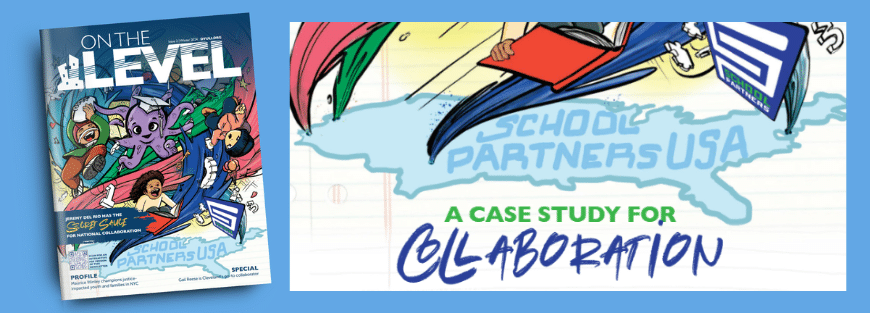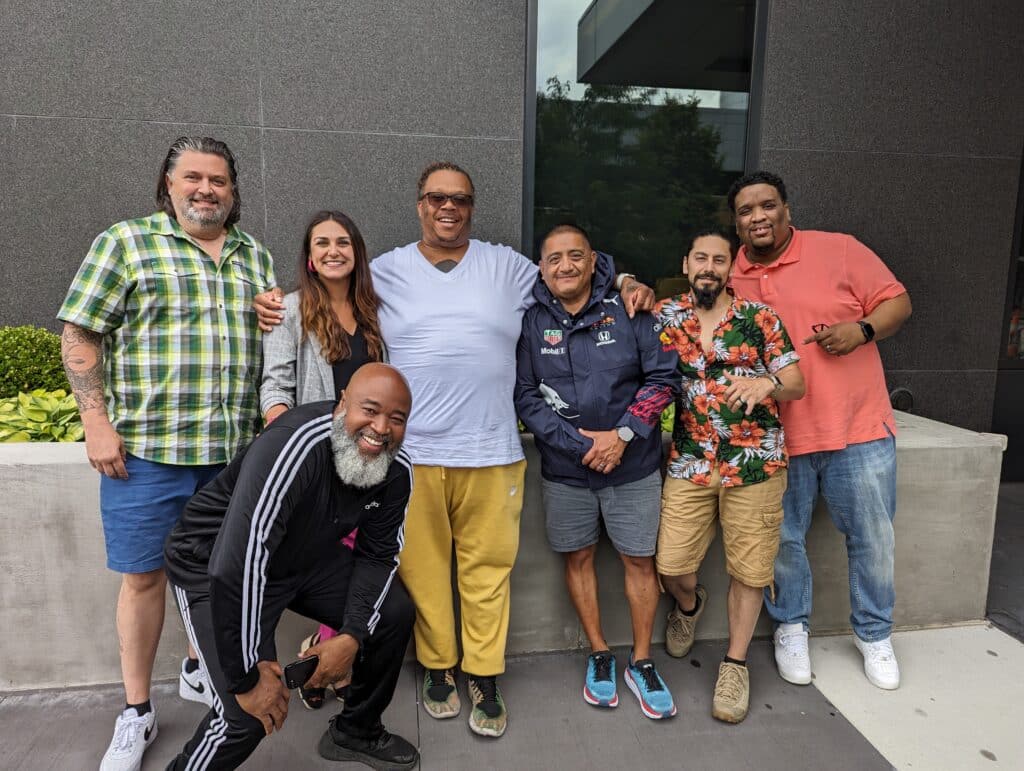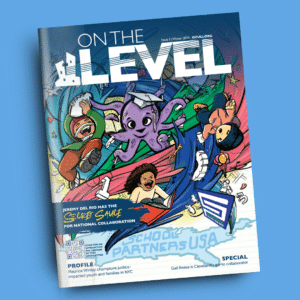School Partners USA
Posted by: Courtney Lampen | December 12, 2024

A Case Study for Collaboration
Article by Ebonie Davis (Washington DC 2022)
Original Cover Artwork by Kekoa Hubbard (Oakland-SF Baby Area 2021)
Ask Jeremy Del Rio (NYC 2020), and he’ll tell you he learned the most foundational tool for collaboration from a youth, Rollie Barnes, who was the biggest knucklehead in his group. The teen spent much of his time poking fun at the young, optimistic youth pastor (and initially only came because of a girl). He didn’t cut Jeremy any slack. “He was always in my face, asking hard questions and challenging everything I did,” said Jeremy. “This developed resilience in me, and as I stuck with him and invited him back, he kept showing up. It would have been so much easier to keep him away. But I think about him all the time because that kind of tenacity is required to build collaborations that last.”
That tenacity has paid off. Today, the organization Jeremy founded, Thrive Collective, is in its 10th year. Based in New York City, Thrive creates hope and opportunity through arts, sports, and mentoring in and around public schools. At the heart of the organization is a passion for meeting kids where they are in a tangible, concrete way.
Jeremy describes the early collaboration that undergirds Thrive Collective’s success as “organic.” He recalls, “We’d find people who were of like mind and like heart in different places and encourage one another with stories, best practices, ideas, and resources.” Some of those early connections were through DVULI and other organizations. A hot topic in this growing network was how Thrive was successfully engaging with schools and what that process looked like. Jeremy openly shared everything he knew: “Freely we have received, so we’re going to give it away!” He credits this philosophy with deepening the relationships within their network of youth workers.
The pandemic pause gave Jeremy and his team the time to go beyond informal shared learning and think more systemically about their work. This gave birth to School Partners USA (SPUSA), which provides tools, training, and coaching to help youth workers partner with public schools.
This gave birth to School Partners USA (SPUSA), which provides tools, training, and coaching to help youth workers partner with public schools.
“We were able to extrapolate what worked and what didn’t and share it in a much more proactive and structured way,” said Jeremy. Alongside NYC, they launched in Dallas, San Diego, and Oakland, with local city coordinators (DVULI alums) who were similarly engaged with the public schools in their respective cities.

(PHOTO CAPTION: From left to right in back: Jeremy Del Rio (NYC 2010), Tara Bollinger-Oksuzler (Dallas 2019), Demorea “Truck” Evans (Oakland-SF Bay Area 2017), Carlos Nicasio (San Diego 2008), Kekoa Hubbard (Oakland- SF Bay Area 2021), Lawrence Coles (NYC 2010), and Fred Lynch (Dallas 2011) in front.)
There was no need to reinvent the wheel when it came to training resources. SPUSA used the DVULI framework, content, and processes as a replication pilot for the organization. This is a valuable yet underutilized resource, and Jeremy encourages alumni not to leave it on the table. “At the end of every local workshop and national conference, DVULI gives you the keys,” explains Jeremy. “We walk out of those experiences with all the ingredients to either replicate it as presented or tweak it and customize it to your organization’s needs. The invitation for seed grant money is always offered to every cohort. However, I very rarely saw anybody run with it. We took DVULI at their word, leveraged the funding that was available, and the result has been amazing.”
The invitation for seed grant money is always offered to every cohort. However, I very rarely saw anybody run with it. We took DVULI at their word, leveraged the funding that was available, and the result has been amazing.
Learn More about DVULI Collaboration Grants
Each SPUSA city has its own unique application of what it means to partner with schools in their local context, but some elements of successful collaboration remain true across the board. Jeremy says it is important to maintain the posture of a servant. “The way Jesus engaged each person He connected with was to serve, listen, and be responsive to their felt needs,” he explains. “I think that’s a universal truth. When we come in with that savior mentality, we undermine collaboration. Finding that sweet spot takes effort, listening, and a lot less talking and prescribing. It’s a discovery process.”
The success of the multicity collaboration also meant that resource networking would necessarily take on a new dimension. Jeremy finds it helpful to think of that in two parts. He explains, “Networking starts by asking, ‘Who do you know?’ As you cultivate those relationships, build your tribe with those whose passions align with your own.” Jeremy also cautions against spending too much time commiserating. “At some point, people get tired of just talking about problems or dreaming about solutions. Translating that shared commitment into a project, event, or initiative gives the relationship fuel. People want to know that their time investment adds value.”
 To be able to resource well, leaders must clearly define what they feel compelled to do, break that down into its component parts, and then ask, “Where do I get that stuff?” Jeremy has often found that within his network, he was a lot closer to what he needed than he realized.
To be able to resource well, leaders must clearly define what they feel compelled to do, break that down into its component parts, and then ask, “Where do I get that stuff?” Jeremy has often found that within his network, he was a lot closer to what he needed than he realized.
“Where do I get that stuff?” Jeremy has often found that within his network, he was a lot closer to what he needed than he realized.
As the organizations grew and he began to seek funding beyond grassroots donors, he found it helpful to diversify funding sources to include local institutions, businesses, churches, civic associations, and government.
Click to View Jeremy’s SPUSA Today Show Segment
Recently, Thrive Collective was commissioned to produce a mural in honor of the Today Show host Hoda Kotb’s 60th birthday. It was Thrive Collective’s 600th mural completed over a decade as an arts education nonprofit. Jeremy is quick to point out that he is an “accidental curator.” He can’t do any of the work that Thrive has a reputation for producing, but with some tenacity, he could be a catalyst for collaboration.
Reflecting on that knucklehead youth, Jeremy is grateful for the way the teen transformed him. “There’s been a lot of beautiful results, and that’s because of the commitment to wonder—always asking and always being open to the unexpected.”
Click to read the late Rollie Barnes’ testimony.
Watch Jeremy’s video highlights below:

